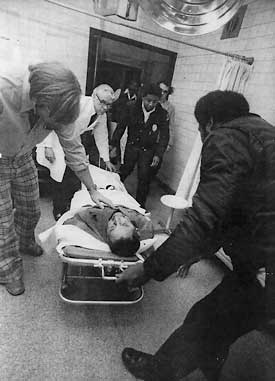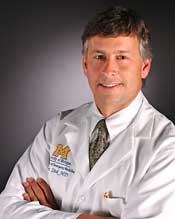Emergency medicine aided by motley revolutionaries
By Mary Beth Reilly
Medical School Communications
If it weren't for some quirky, largely Midwestern physicians, U.S. emergency rooms (ERs) still might be stuck in the 1950s model, according to a U-M physician who has researched more than 60 years of ER medicine.
At that time, most ER patients were seen by surgeons—if they could be spared from the operating room—private practice physicians or those with questionable credentials, while some ERs were staffed by unsupervised residents and medical students. So notes Dr. Brian Zink, author of "Anyone, Anything, Anytime, A history of emergency medicine," the first book on the post-World War II history of emergency medicine.
Zink, a practicing ER physician, associate dean for medical student career development and associate professor of emergency medicine in the Medical School, was moved to chronicle this historical shift when he realized the window of time to hear the story of emergency medicine directly from its founders was closing. He interviewed dozens of early revolutionaries and found them to be interesting characters.
"They were more likely to have grown up in the Midwest, they were less likely to be Ivy League-educated, and they were not plugged into the medical elite in this country," Zink recalls. "They were starting something new on a grassroots basis."
 |
The uniforms look a little different and the procedures have become more advanced, but emergency medicine still is about treating patients with the smallest injuries or biggest traumas. Above: Robert Wolfensperger, emergency medical resident and program director (left), and Dr. Allen Klippel (white coat) assess the condition of a patient in the St. Louis University Hospital in 1973. (Photo by Medical World News) Below: Dr. John Erickson, an orthopedic surgeon at the U-M Health System, treats field hockey player Sara Wilhite in the University Hospital emergency room (ER) for an injury. Dr. Brian Zink, a U-M ER surgeon, has written the first book about the post-World War II history of emergency medicine. (Photo by Scott Galvin,
U-M Photo Services) |
.jpg) |
One of the people featured in the book is John Wiegenstein, a 1960 Medical School graduate, who most often is mentioned as the father of modern emergency medicine. Born in a Missouri cabin, an ex-seminarian who tried automotive engineering and flight school, he finally settled down to learn and practice medicine. Although he began as a general practitioner in Lansing, Wiegenstein found he most enjoyed being awakened in the night to come to the ER to treat his patients. While there, he saw that many of the physicians either were misfits or not trained to make lifesaving decisions.
In 1968 Wiegenstein gathered several other like-minded physicians and founded the American College of Emergency Physicians (ACEP), the premier professional association in the field. His goal for the ACEP was to create national awareness of the need for qualified emergency care and training; to promote research in emergency medicine; and to develop emergency medicine as its own, board-certified specialty.
"Wiegenstein was surprisingly modest," Zink says. "Very much driven by values, he kept pursuing in a very determined way what he saw needed to be done, which was to form a strong organization in order to propel good emergency care to our patients."
Ronald Krome was another revolutionary. He served as a crucial link between early emergency medicine practitioners and the academic world. Fresh from his surgical residency in 1969, Krome was put in charge of the emergency department at what used to be called Detroit Receiving Hospital. One of his first decisions was to designate one—and only one—entrance to the ER.
Zink recalls Krome as being funny, gruff and irreverent, but with a good sense of humor, chain-smoking cigarettes throughout the interview.
"Pretty much everything that happened that was important in emergency medicine in the 1970s and 1980s, he was a part of it. He was a tough negotiator, but knew how to cajole, so he was effective in working with the medical establishment," Zink says. "They didn't quite know what to make of emergency medicine, and their initial reaction was to shut it out.
"Krome was up for the battle to get emergency medicine into the legitimate house of medicine."
Karl Mangold represents the entrepreneurial side of emergency medicine. He took a systems approach to anything he did, be it caddying, delivering newspapers or delivering lifesaving medical care, Zink says
Mangold saw that many hospitals needed to staff their emergency departments but didn't have locally qualified physicians. In 1966, he co-founded Fischer Mangold, a company that supplied qualified emergency physicians to hospitals by contract.
"Mangold's goal was to deliver better emergency care to populations than they had gotten previously," Zink says." Other similar corporations became exploitative in that they were not hiring the best qualified emergency doctors, and that's an ugly side of emergency medicine that is still being played out today."
Emergency medicine also had its critics. Oscar Hampton, chair of the Committee on Trauma of the American College of Surgeons in the 1960s and 1970s, was so outspoken that he served as the perfect foil in the struggle to make emergency medicine a recognized specialty, Zink says.
"It was paradoxical that Hampton, like many other surgeons, would want better trauma care for emergency patients, but he viewed it as only a surgical domain, and not something to be shared with other physicians," Zink says.
"Hampton reacted vigorously against an organized emergency medicine specialty, although in later years some people said Hampton knew he wasn't going to win that battle, but he had so much fun engaging in it that he was almost a caricature."
Having a nonconformist background both helped and hurt these revolutionaries. It helped them to understand what medicine needed at the time, but it hurt them because they didn't fit into the academic world, Zink says. But they were aided by the social and political changes of the 1960s and 1970s, so in the end emergency medicine became a valid, recognized and valuable medical service.
Today, the ACEP has more than 20,000 members. |



.jpg)
